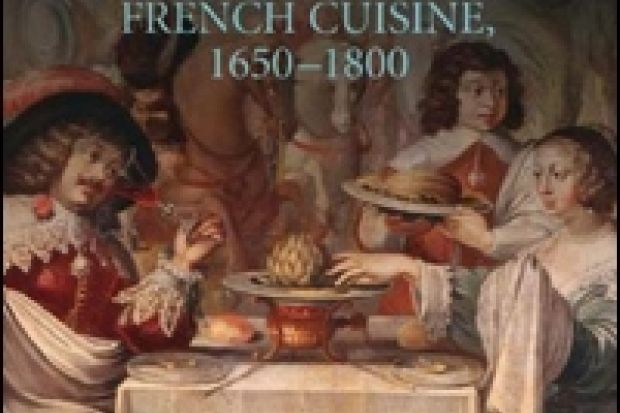French cuisine underwent a dramatic transformation during the early modern period. All kinds of new products became available: potatoes, pumpkins and turkeys from the New World; chocolate, coffee and tea from the New World and the East; newly developed strains of Mediterranean vegetables and fruits such as asparagus, spring cabbage, oranges and pears. Vinification and storage techniques were developed, so that eventually wines could be aged in their bottles. Burgundy became the dry Burgundy we now know, with the potential for a deepening of aromas and flavours; and the sharp, thin wine of Champagne underwent a second fermentation and was reborn as a round and powerful fizz.
Meanwhile, the system, style and indeed the philosophy of cooking in France underwent a sea change. In 1500, the elite classes of France were accustomed to a kind of international Gothic cuisine. Foods were heavily spiced; flavours were layered, involving sweet, salty, tart, bitter and peppery elements all at once. The elite medieval cook liked to transform one thing into another; for example, making minced fish into a baked mould that resembled a roast of lamb. Cooks also liked to serve big joints of meat, and even large whole cooked animals. Sauces were sharp, although frequently thickened with ingredients such as bread crumbs and almond paste, and diners ate communally, off shared serving dishes, usually with their hands.
By 1800 all that was gone. A decisively French cuisine had been born, which strived for such qualities as "delicacy" and "sincerity". Savoury items were kept distinct from sweets, and traditional spices, such as saffron, ginger and cinnamon, were all but banished from the former. Instead of mixing things up, the modern French cuisine tried to make each main ingredient taste of itself - the fish would taste of fish, the pork would taste of pork - and instead of serving highly contrasting flavours, it tried to feature complementary ones. Liaisons of butter, cream and egg yolks, combined with long simmered stocks, came to reign. Aromatics such as parsley, bay and thyme would serve as nearly universal flavourings. Dishes in small portions would now be served with a great concern for complementarity and procession, in set geometrical order and chronological sequence, and eaten off separate porcelain plates, with knives and forks and other delicate instruments. And although the new haute cuisine could be very costly and elaborate, an ethic of simplicity for the sake of simplicity also ruled.
The story of the transformation of French cookery in the 17th and 18th centuries has been told before, and told often. Unfortunately, Susan Pinkard's A Revolution in Taste has very little new to offer. Pinkard has not done a lot of original research; instead, apart from fresh readings of about half-a-dozen cookery books of the period, she has recycled material from other historians - Jean-Louis Flandrin, Stephen Mennell, Sarah Peterson, Jean-Robert Pitte, Rebecca Spang and Barbara Ketchum Wheaton, among others. She has not uncovered any new information, or even tried to do so for that matter, and she has not added any new ideas to the general account of the history of French food. A Revolution in Taste is clear and lively in its presentation and carefully annotated; it shows an excellent understanding of how food is prepared and it makes for good reading. But it is faulty in places and self-contradictory in others; sometimes it is downright inaccurate; and in the end it is unnecessary.
Pinkard spends a lot of time, for instance, discussing the relationship between dietary science and the culinary arts - an important subject, since medicine and cooking were very intimately allied in pre-modern Europe. But Pinkard has not indicated that she has read a single pre-modern medical author, apart from the late and idiosyncratic (and English!) physician George Cheyne (1671-1743). Had she read other (and earlier, French) authors she would have found that pre-modern medicine was far more concerned with physical sensation and feelings of wellbeing than she gives it credit for, and she would have found in it a vocabulary not only for dubious metaphysical speculation - an idea she adopts whole cloth from historian Nancy Siraisi - but also, much more importantly, for pleasure. And she may then have thought a little bit harder about pleasure and its varieties, and how the French came to develop and systematise a certain form of it that has long since dominated fine dining around the world.
The real question now is not what the French came to eat and how - we have understood that for quite some time. The real question is why. Why the French? Why do they have that particular intensity of interest and systematic elaboration, up and down the social scale? Why this "revolution", if that is the right word? (I have my doubts.) And why 1650? These are not questions, however, that Pinkard has asked, let alone answered.
A Revolution in Taste: The Rise of French Cuisine 1650-1800
By Susan Pinkard. Cambridge University Press 334pp, £20.00. ISBN 9780521821995. Published 1 November 2008
Register to continue
Why register?
- Registration is free and only takes a moment
- Once registered, you can read 3 articles a month
- Sign up for our newsletter
Subscribe
Or subscribe for unlimited access to:
- Unlimited access to news, views, insights & reviews
- Digital editions
- Digital access to THE’s university and college rankings analysis
Already registered or a current subscriber? Login
